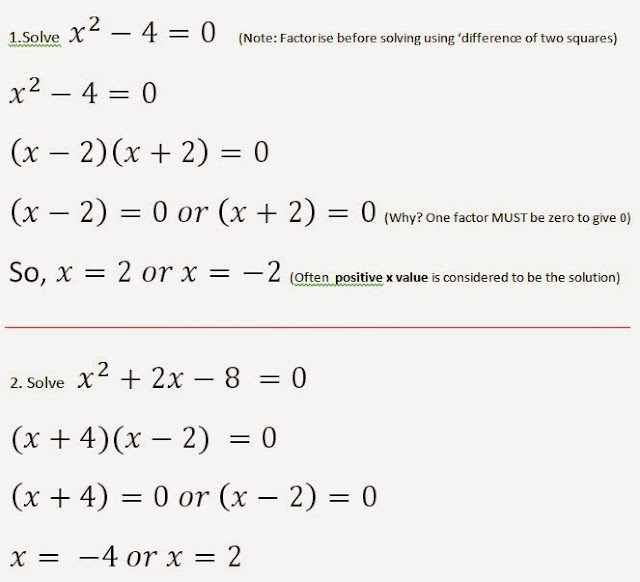If this PDF file does not open, click on 'Open in new window' arrow. (Here ▼)
Addition Methods | Adding by Parts
Adding two or more numbers can be fun and easy when done in parts - by parts I mean unit, ten, hundred,....
For example
Work out the value of 5 + 15 + 34 + 58 + 72
add the tens: 10 + 30 + 50 + 70 = 160 (you see, 70 + 30 give 100, 10 + 50 give 60 )
add the units: 5 + 5 + 4 + 8 + 2 = 24 (5 + 5 = 10, 8 + 2 = 10: that's 20, plus 4 give 24)
Now add 160 and 24
160 + 24 = 184
-----------------------------
Maths is Fun ^o^
For example
Work out the value of 5 + 15 + 34 + 58 + 72
add the tens: 10 + 30 + 50 + 70 = 160 (you see, 70 + 30 give 100, 10 + 50 give 60 )
add the units: 5 + 5 + 4 + 8 + 2 = 24 (5 + 5 = 10, 8 + 2 = 10: that's 20, plus 4 give 24)
Now add 160 and 24
160 + 24 = 184
-----------------------------
Maths is Fun ^o^
GCSE Basic Algebra Questions and Study Guides 2022 Exams
There are four basic parts in GCSE algebra that you should know when revising for the maths papers. They are:
- 1. Substituting
- 2. Expanding
- 3. Factorising
- 4. Solving
GCSE Algebra Questions
Algebra is often regarded by both students and teachers as a tough topic to learn or teach.
Yet, you will do well if master the four skills. The skills are the same in primary (Years 5, 6, 8) and secondary (Years9, 10, 11, 12).
Basic Algebra Questions
Below you'll find some basic algebra questions (and solutions) addressing the four skills. The questions were adapted from the UK GCSE maths exam papers.
SEE MORE ON GRADE 10 EXAM QUESTIONS HERE
1. Substitution
a. Write
down the value of abc when a = 10, b = 2 and c = 0
The answer is 0 (but, many students will write 20) ……………..1 mark
Maths knowledge: any number multiplied by 0 is 0
b. Work out
the value of 1/2x - 3y
when x= 10 and y= 2
2 marks
c. Find the
value of 3x + 2y when x = 4 and y = 5
2 marks
2. Expanding Brackets (note that expanding and factorising are opposites)
Expand the following expressions
a. 3(2y – 5)
= ……………..1 mark
b. 4(2m +
3n) = ……………..1 mark
8m + 12n
c. x(x – 10)
= ……………..1 mark
3. Factorising
Factorise
the following expressions (note that expanding and factorising are opposites)
a. 2a + 10
=
……………..1 mark
Highest Common Factor (HCF) of 2a and 10 is 22(a + 10)
b. 4 + 6x
=
……………..1 mark
HCF = 22(2 + 3x)
c. 3x –
9=
……………..1 mark
3 (x - 3)
d. 2x^2
+ 4x
2 marks
4. Solving equation
Solve the
following equations to find the value of x
a. 4x =
20 ……………..1
mark
x = 5
b. 3x - 7 =
8 ……………..1
mark
c. 8(x + 12)
= 100
2 marks
Check out past algebra questions and maths resources here.
GCSE Foundation Maths Algebra Questions
Solve the
following to find the value of y
a.
y/3 = 9 ……………..1
mark
b.
2y/5 = 4
……………..1 mark
2y = 20.......... ( 20 = 5 x 4)y = 10
c.
2y + 3 / 2 = 5
2 marks
Where to get GCSE Maths Questions?
There are four GCSE exam boards where you can get the maths past paper Pdf for free AQA, Edexcel, SQA and OCR.
The exam boards also provide the marking schemes, examiner reports, and practice materials.
Check out the resources here for more information on GCSE maths exams, study guides and past papers.
Division Methods | Long Division and Division by Chunking
These two methods can be very useful. I recommend introducing them together - give the students options to work with.
-------------------------
Method 1 - Long Division
Solve 351divided by 9
Method 2 - Division by Chunking - This is about calculating in parts
Solve 351divided by 9
351
81 (9 x 9) .....you know that from x9 table
----
270 (9 x 30)
ANSWER 39 ......add 30 and 9 to give you the answer (easy aye :))
YOUTUBE Links
Long Division
Division by Chunking
-------------------------
Method 1 - Long Division
Solve 351divided by 9
Steps
1. 9 goes into 35, 3 times
2. 9 x 3 - 27
3. 35 - 27 = 8 ......bring the unit, 1, down. That makes 81
4. 9 goes into 81, 9 times.
5. Now, 81 - 81 = 0....no remainder, the answer is 39
Note: If there is remainder, your answer will be a mixed number (or a decimal number)
Method 2 - Division by Chunking - This is about calculating in parts
Solve 351divided by 9
351
81 (9 x 9) .....you know that from x9 table
----
270 (9 x 30)
ANSWER 39 ......add 30 and 9 to give you the answer (easy aye :))
YOUTUBE Links
Long Division
Division by Chunking



